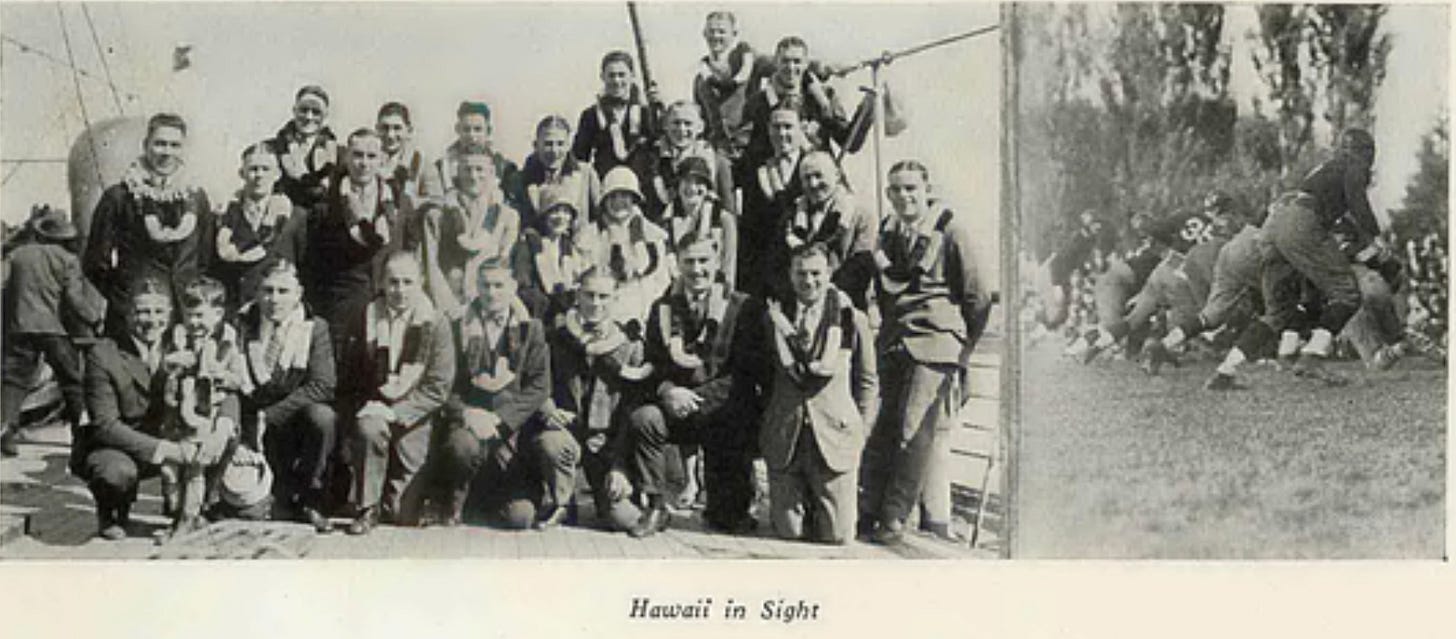Today's Tidbit... 1925 Washington State Football and the Ferentz Challenge
Much was made of the Iowa Hawkeyes scoring challenges this season, including the requirement that Brian Ferentz's offense average 25 points per game for him to retain his role as Offensive Coordinator. Of course, they recently let him go regardless of his final point total, but the episode established the minimum measuring stick of scoring 25 points per game. Almost one hundred years ago, there was reasonable doubt whether Washington State's team would score 25 points in the entire season, so we'll look at that season in Today's Tidbit.
Washington State football had success under Lone Star Dietz, a former Carlisle player, who led them to the 1916 Rose Bowl and several other competitive seasons. After Dietz left, Gus Welch, a second former Carlisle player, had early success before falling off, and he was followed by Albert Exendine, a third former Carlisle man who had winning records at Otterbein and Georgetown.
Exendine arrived in Pullman, needing to build up the team. Unfortunately, Exendine's 1923 team went 2-4-1 (1-3-1), and his 1924 team did worse at 1-5-2 (0-4-1), though it played better than the year before. Exendine thought he might turn things around in 1925, a season that ended with two games scheduled in Hawaii over Christmas break. Unfortunately, the season was filled with injuries, illness, and uninspired play.
Their season opener was a Pacific Coast Conference game at Montana, where the Cougars managed three field goals and held the Grizzlies scoreless to earn a 9-0 win.
Two weeks later, their home opener against conference foe Idaho started similarly, with Washington State getting two field goals in the second quarter. Idaho scored on a 65-yard fumble return in the third quarter and converted, giving them a 7-6 lead, which withstood a last-second missed field goal attempt by the Cougars.
Averaging 7.5 points per game after the first two games, State was blown out at home by Washington, 23-0, and on the road at California, 35-0.
Standing 1-3 (1-3), their next contest came against nonconference and crosstown rival Gonzaga. The teams played to a 0-0 tie the previous Thanksgiving, but surely this one would be different, right? It wasn't. Despite the two teams slugging it out with little to show for it, their fans remained engaged.
Never downhearted and always hoping for the score that never materialized, the W.S.C. and Gonzaga students kept up their concerted cheering to the very end.
'Gonzaga Eleven Out-Gains Washington State In Fiercely Fought Scoreless Tie Before 8000 Fans,' Spokesman-Review (Pullman), November 22, 1925.
Unfortunately for the Cougars, Gonzaga outgained them 212 to 148 in the 0-0 game, bringing their scoring average to three points per game.
At that point, Exendine recognized it was time to go, and he resigned following the game, though the resignation was to take effect after the Hawaii trip. As Exendine told reporters:
The boys down here just don't want to play football for me. Even allowing for the illness which has dogged the team this season, I am unable to understand why the boys have not fought as they should. Maybe they will deliver better stuff for someone else.
'Exendine Announces Resignation As Football Coach At Pullman,' Spokane Chronicle, November 23, 1925.
After Exendine's resignation, their next game came in the Los Angeles Coliseum against a heavily favored USC. The Trojans stood 9-1, with a roster that included Marion Morrison, better known as John Wayne, so it took true grit for the Cougs to ready themselves for the men of Troy.
But football is a funny game. There was no reason for the Cougars to play well against a far more talented Trojan team, but they did. The Cougars started things with a 45-yard kickoff return, followed by a 40-yard touchdown run to take an early lead. USC scored in the first quarter after a bad WSU punt, and State followed with a second-quarter field goal to make it 10-6 at the half. USC then grabbed the lead with a third-quarter touchdown as the win probability curve swung in USC's direction. However, the Cougars tossed a pass 20 yards downfield and added 35 yards of touchdown-producing YAC, allowing them to beat their season-to-date scoring total and the Trojans.
The score also meant the Cougars had put up 32 points on the season, surpassing the 25-point mark with more opportunities in store during their trip to Hawaii one month later. The plan was to play a Honolulu club team on Boxing Day and the University of Hawaii on New Year's Day.
As things turned out, WSU clubbed the Honolulu Town Team 24-7 and then were lei'd out by the hard-hitting university boys 20-11. Adding the 52 points scored in their last three games to the 15 they managed in their first five upped their average but left them at a Ferentzian 8.375 points per game.
Following the season, Albert Exendine returned to his law practice in Oklahoma. He continued coaching in the fall when he took over at Occidental for two years, Northeastern State for one, and finished his coaching career with four years assisting and two years as head coach at Oklahoma State.
Washington State hired Babe Hollingberry to take over the program in 1926. They went 6-1 in his first season. Hollingberry, who never attended college, remained in Pullman for 17 years, bringing the Cougar faithful their most prolonged success as he finished with a 93-53-14 (64-42-10) record, including an appearance in the 1930 Rose Bowl.
Football Archaeology is reader-supported. Click here to buy one of my books or otherwise support the site.







Interesting story. I wonder if Wash St had the three Carlisle connected coaches based on recommendations (at least for Welch and Exendine) from their predecessors?
True grit…I see what you did there!!